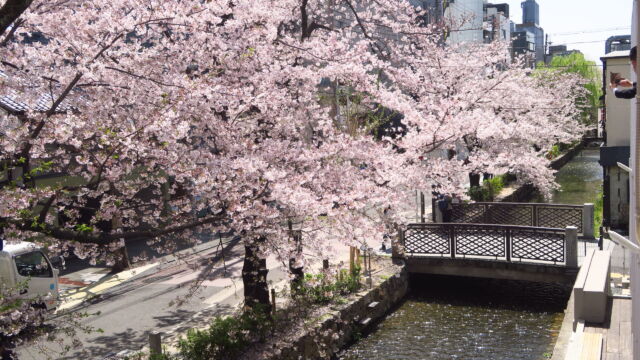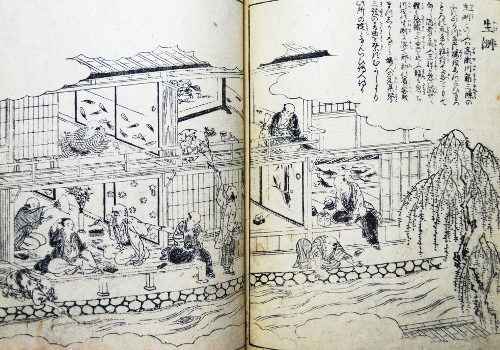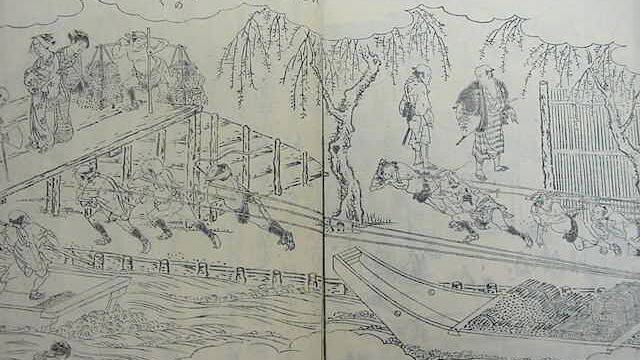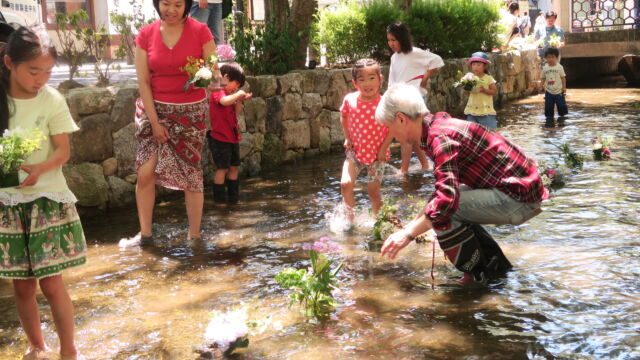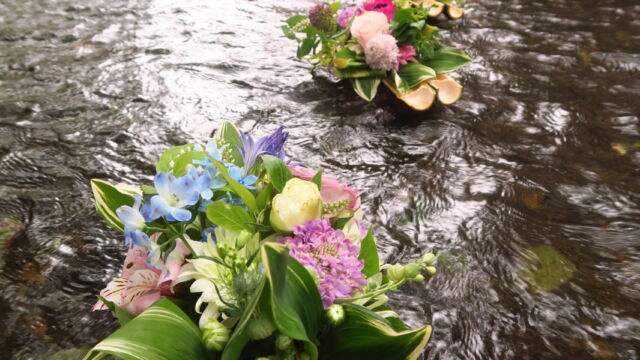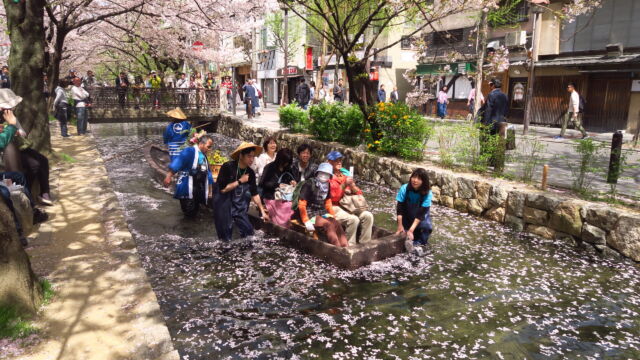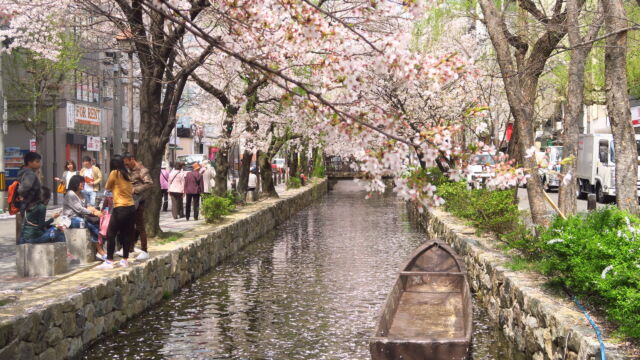Florist Westvillage is located on Kiyamachi street.
It is one of the most famous spots in Kyoto city. There are many restaurants, pubs and clubs which attract many people. Although Kiyamachi is considered an ordinary area by people who visit here including people from Kyoto, actually it has an interesting history. The key to understanding it, is the stream of water called Tagkasegawa which runs along the street. The stream looks like an ordinary stream but it used to be a canal, constructed at the beginning of the 1600s.
At the beginning of the 17th century, almost the whole island of Japan had unified. The government which had lasted for 200 years brought Japan to a stable prosperity. Many of the Japanese traditional customs inherited today, including Ikebana, have remained unchanged since this era. But at this time, this area, which is the centre of Kyoto now, was only a river beach at the edge of the capital.
The original city plan of Kyoto which was created in the 9th century, was based on the ancient Chinese city plan which was based on the Chinese philosophy “Feng Shui”. In this concept, in the creation of the city, there should be the “four animal gods” in each four directions, north, south, east, west, for the city to be protected. The black turtle god should be in the mountains in the north, the white tiger god should be on the endless road in the west, the vermilion bird god should be in the lake on the south, and the blue dragon god should be in the river at the east. When ancient people decided to move the capital, they looked for an area which fulfilled these conditions. The place which is called Kyoto today, was founded in this way.
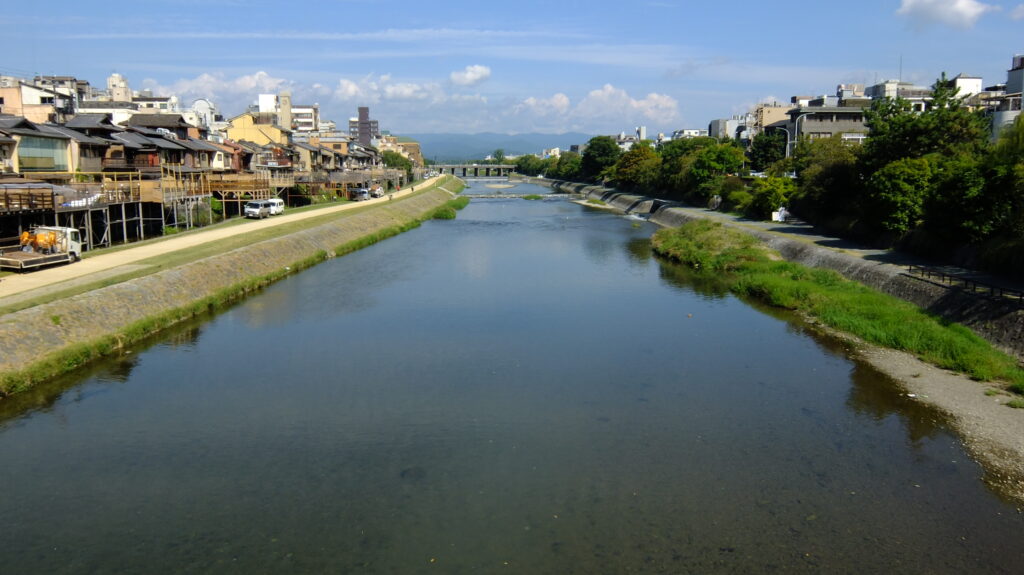
As Kyoto city developed as an early modern city, the demand for wood increased to build many houses and temples. Although it seemed easy to get wood in Kyoto because of the surrounding mountains. Actually it was impossible. The required length of wood is generally 4.2 meters, so it was difficult to carry the wood directly from the mountains to the city. There was a man who became successful as a merchant. He had the idea to carry the wood along rivers in the surrounding mountains and to collect them at the south of the city. Fortunately there was a lake where a lot of wood could be kept because of the ancient city plan. Then they carried them against the flow of the river which was located on the east edge of the city. This was Kamogawa river which has been the symbol of Kyoto until today.
But he quickly found a difficulty with the plan. The flow of the river was too rapid compared to human power. Finally he got the idea to build the canal on the river beach of Kamogawa river. After 2 years of construction, the canal was completed. People gathered to start businesses as a lumber whole seller or a timber merchant. Wood was required not only as a construction material but as fuel for daily life. In the peak period, there were more than 700 boat men and 150 boats. People started to call the street Kiyamachi which means wood-shop-town. The success of the canal brought precious things to Japan. The canal allowed Kyoto access to wood, which allowed Kyoto people to live in more modern houses. It is in this type of house that the culture like ikebana or tea ceremony was able to develop. Before this era, the houses of ordinary city people were constructed only with pillars and a roof without a floor. What the canal brought to Kyoto was not only wood but also cultural prosperity to remain as the capital.
There are some restaurants to attract merchants and travellers on Kiyamachi street and a back ally between Kiyamachi street and Kamogawa river. The ally is called Pontocho street which is known as the Geisha district today. A Geisha is a dancer and specialist of hospitality. The origin of the Japanese traditional dance is a gift for the gods. Enjoying seasonal dishes with local Sake and watching Geisha dancing with the concept of their dance expressing seasons, is one of the richest ways to spend time in Japan. The culture of Geisha contributes to the development of not only Japanese food culture, but also Japanese fashion. Geisha need beautiful Kimonos and accessories which are made in traditional ways. In the space where people enjoy the food and time with a Geisha, calligraphy or Ikebana flowers are of course needed. Tourists especially from foreign countries are eager to walk along Pontocho street to see the Geisha and never care about Kiyamachi. But without the canal, the Geisha district would not have developed here.
In the early 20th century, the prosperity of the canal ended when it became usual for people to use trains to carry materials. Before long, shops on the street started to handle general goods or grains and liquor. Some of the town names in the Kiyamachi area relate to wood, others relate to everyday items. Today, restaurants and pubs have increased as elderly people close their shops. It is not timber street anymore but still attracts many people. In this way, Kiyamachi area which used to be on the edge of the city became the centre of Kyoto.
Many people visit Kiyamachi today, but most of them don’t know this history and only come to drink alcohol and have fun. Nobody, even Japanese people, cares about this stream of water which has contributed a lot to Kyoto city. Most elderly people who know the history have left the town. They were also the people who stopped the government plan to reclaim the canal to make the car road wider.
This preserved stream should be a treasure for the people in Kyoto. To pass down the history, I took over a leadership position of a local volunteer group, which has a boat for the Takasegawa canal. This flat bottomed boat is called Takasebune-boat, the origin of the name of the canal, which is useful for carrying many items on this shallow stream. We keep this boat to remind people of the history of Kiyamachi. We present this boat experience twice a year and hold an event to arrange flowers in the water to focus attention on the canal and its history for everyone in a fun way.
When tourists think about Kyoto, they think about old temples and shrines. They are actually very popular and extremely crowded every day. But it is just a small part of Kyoto. Kyoto has a long history. Even small streets that look ordinary at first glance, like Kiyamachi street, have interesting stories to tell. I think we can say the same thing about all of the Japanese cultures including Ikebana. It looks like just a form of flower art with different designs from western designs, but it carries a long history and the Japanese way of thinking, connected to other cultures and arts.




